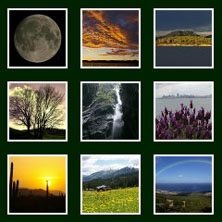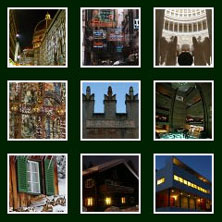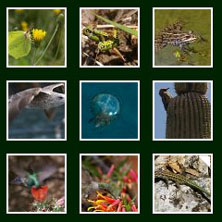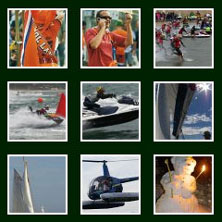A travel experience.
February, 11 2008: AF 2509 vs. TGV9577
From time to time I'm in Paris for business, all the years I took always the plane. Since June 2007 there is a high speed train connection between Paris and Stuttgart served by the famous French TGV. So this time I take the plane in the morning and I'll travel back by train on the same day evening. I’m curious what is faster what is more convenient. Here's my story:
The way to ParisScheduled start for my morning fight in Stuttgart is 7:15h. Latest check-in is 6:45h. I have to leave the house at 6:00h; my girl friend was so nice to bring me by car to the airport. It takes only 20 minutes from home to the airport. The check-in is easy with the self service terminals Air France and the other airlines have today. I've plenty of time, so I stop by a newspaper stand for some magazines.

Check-in Stuttgart
Next step is the security check; for a Monday morning the line is quite short. It takes me just five minutes to get through. Ok, I know the terminal quite well and go to the gate. Nice, I meet a friend on the way to Hannover.
On the gate they announce the boarding will start 10 minutes late. No problem with that. After boarding the flight attendant tells us there is some further delay and we have to wait for our start slot. Waiting is not so bad, I’ve a whole group of three seats for myself although the plane is well booked.
At 7:40h we leave our parking slot. And finally at 7:45h, with a 30 minutes delay, our Airbus A320 lifts off.
I'm leaving Stuttgart 1:45h after I left my house.
We start towards East which gives me a great view on the sunrise at the mountains of the "Schwäbische Alb" and the foggy valleys. As we have a higher elevation one can see the Alps in more than 200 km distance behind the "Schwäbische Alb". What a view!

The "Schwäbische Alb" in front and the Alps on the horizon
"Getting down to earth" again, since I'm sitting in the last row, I'm the first who is served in the Economy class: a croissant, tea or coffee, and... some water, no orange juice anymore! Is this a low budget airline? I don't think so?
The flight is calm and seems to be quite short with a beautiful blue sky. At 8:20h we decline already, but it is not the preparation for landing, we go for a waiting loop. We fly by the Charles-de-Gaulle-Airport and have a view on downtown Paris as well as on the old airport Le Bourget.

Tour Montparnasse, Tour Eifel and La Defense
At 8:45h we touch ground and after another 5 minutes we are at the gate. Finally I step into the airport at 8:55h. And surprise, we are not at the final terminal. We are directed in a bus that transfers us to the final terminal 2D. It's now 9:05h.
3 hours and five minutes after I left my house I arrived in Paris, now I've to get to the city for my meeting.
The taxi line is short, so I'm five minutes later in my cab, let's see how the traffic is today.

Indian quater close to Gare du Nord
Surprise, the traffic is fine just up to Stade de France. And then the usual traffic jam in the center of Paris. 48 Euros later, at 10:03h I'm at my final destination. Four hours and three minutes after I left my house.
The ReturnI left our meeting place 16:50h, in front of the building is the metro station. The line serves Gare de l'Est directly. Buying a ticket is fast and the signs to the Metro line are good visible. Just some seconds after I arrive at the platform the Metro arrives. It takes four stations to Gare de l'Est, it's exactly 17:00h. Again good visible signs show the direction to the long distance trains. But then I'm a little bit confused, on the screens are several TGV- and ICE-connections including the one to Stuttgart but only a few of them have a platform noted. No platform for the train towards Stuttgart. What now? In the center of the station are the regional trains, I go to the outer platforms, and there they are: the TGV- and ICE-trains, but again only one platform’s screen shows where the train goes to - no Stuttgart! I ask one of the attendants and they tell me friendly which TGV is supposed to be the one to Stuttgart.

Which platform is it?
Ok, plenty of time, 20 minutes left to the departure. I buy a soft drink at a stand, take some pictures of the train station and return slowly. Ten minutes before the scheduled departure the screen shows the Stuttgart-train and now all the waiting passengers move towards the train.

TGV and ICE at Gare de l'Est
The departure is on time at 17:24h. For 6 minutes, the train moves quite slow through the surrounding area of the train station and accelerates than the first time a little bit in the suburbs of Paris. And on 17:40h finally the speed is quite high, there is no speed written on a screen but I guess it is far beyond 200 km/h, maybe even more than 300 km/h!
Meanwhile the friendly train attendants check the tickets, it is a bilingual team from the SNCF and Deutsche Bahn - hey the Deutsche Bahn crew had to learn English for the Soccer World Cup 2006 and it is still funny when they announce the stations in their mixture of a German local dialect and English.
After almost one hour at high speed we slow down at 18:35h. With this slower speed we continue until we reach at 19:45h our first stop at Strasbourg. The train was quite packed since Paris and is still good occupied when we leave Strasbourg after four minutes. Through the suburbs of Strasbourg and over the Rhine bridge the train continues slowly. On the German side of the river Rhine the train speeds up, but it is not as fast as during the first hour.
Nice, during the travel I can stand up, walk around. The train is compared to the plane really noiseless and I have my iPod with low volume on.
20:29h the second stop in Karlsruhe for 3 minutes. After Karlsruhe, first the train is going slow, but for the last 10 minutes it is again close to 300 km/h. The train is passing some tunnels that increases the pressure in the train and it is like flying you have to swallow to regulate the pressure on the ears.
21:07h we arrive almost on time in Stuttgart. 4 hours and 17 minutes after I left my meeting. My girl friend is picking me up at the train station and another 13 minutes later I'm back at home. It is 21:20, 4 hours and 30 minutes after I left the office in Paris.
The summery:
- The travel time is almost the same, the plane is slightly faster (27 minutes), and would be even faster if the flight is on time - which is actually very rare.
- The train is a more relaxed traveling, less noise, less moving around, just a little bit more space for sitting, and the advantage of getting up and walking around.
- The plane gives the impression of faster traveling; it leaves a feeling of less time consumption. I guess that’s because you have to be prepared always for the next step: Check-in, security, boarding, lift-off, landing …
- Of course the time in the train can be used better with working, reading, sleeping...
- The train produces less CO2 - quite important these days with all the global warming discussion.
- And the cost factor: 69 EUR for the train (reg. 95 EUR) and 250 EUR for the flight (reg. 540 EUR) plus the cab.

Interior of the Airbus A320...

... and the TGV ingterior
























